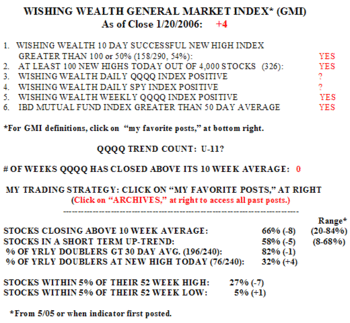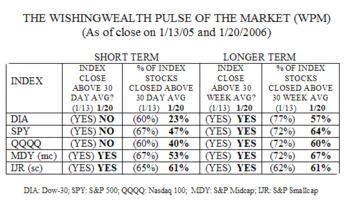Friday was just one of those days. The GMI cannot predict changes in trend, it only provides me with a reasonably certain indication that the trend has changed. The GMI was +6 as of the close on Thursday and fell to +4 by Friday’s close. Could we have anticipated Friday’s rout? Over the years I have noticed that the way that traders react to earnings announcements often provides a clue of things to come. Certainly the reaction to earnings news about YHOO, INTC and AAPL suggested that there might be a tendency to react negatively to even good earnings. Furthermore, when I ran a scan this weekend to look at the largest decliners in the Nasdaq 100 stocks from last Tuesday through Thursday, I came up with the following four largest decliners: YHOO (-14.4%), INTC (-12.23%), AAPL (-6.69%) and GOOG (-6.56%). When the biggest losers are the major big names, it may signify that the market is going to crumble. Hence Friday’s action. Perhaps we have a clue for identifying the next big move down—or up?
So, is this a real change in trend? I am not convinced yet. First of all, the GMI is still at a +4, with the longer term indicators still in an up trend.  And there were a surprising 326 new highs in my universe of 4,000 stocks on Friday. The daily GMI indicators are too close to call, but I counted them as negative. Only 3% of the Nasdaq 100 and Dow 30 stocks advanced on Friday, along with 10% of the S&P 500 stocks. And the QQQQ, SPY and DIA all closed below their 10 week averages, an ominous sign. On the other hand, about two thirds (66%) of stocks are still above their 10 week averages and 32% of the stocks that have doubled in the past year hit a new high on Friday. And more than one quarter (27%) of stocks are still within 5% of their 52 week high. Furthermore, IBD indicates that the put/call ratio hit .94 on Friday, indicating that 94 puts were traded for every 100 calls traded. When this ratio registers greater than 1.00 the market often puts in at least a short term bottom (pun intended). The growing bearishness reflected in the trading of the option traders, suggests to me that we may not be that far away from at least a bounce in the market. So I labeled Friday as the eleventh day (?) in the current short term QQQQ up trend (U-11). Monday’s action could cause me to change the short term trend to down, however.
And there were a surprising 326 new highs in my universe of 4,000 stocks on Friday. The daily GMI indicators are too close to call, but I counted them as negative. Only 3% of the Nasdaq 100 and Dow 30 stocks advanced on Friday, along with 10% of the S&P 500 stocks. And the QQQQ, SPY and DIA all closed below their 10 week averages, an ominous sign. On the other hand, about two thirds (66%) of stocks are still above their 10 week averages and 32% of the stocks that have doubled in the past year hit a new high on Friday. And more than one quarter (27%) of stocks are still within 5% of their 52 week high. Furthermore, IBD indicates that the put/call ratio hit .94 on Friday, indicating that 94 puts were traded for every 100 calls traded. When this ratio registers greater than 1.00 the market often puts in at least a short term bottom (pun intended). The growing bearishness reflected in the trading of the option traders, suggests to me that we may not be that far away from at least a bounce in the market. So I labeled Friday as the eleventh day (?) in the current short term QQQQ up trend (U-11). Monday’s action could cause me to change the short term trend to down, however.
The WPM shows that the weakness in the markets last week was really concentrated in the large cap stocks.  While the DIA, SPY and QQQQ all closed below their 30 day averages, the MDY and IJR ETF’s did not. In fact, more than half of the mid and small cap stocks in these indexes remain above their 30 day averages. But only 23% of the Dow 30 stocks closed above their 30 day averages. In contrast, all five indexes and their component stocks remain above their longer term 30 week averages. The divergence between the large cap stocks and the small and mid caps in the short term 30 day averages is dramatic and suggests that the rout was aimed primarily at the Dow and Nasdaq tech stocks. In fact, over the past week, 43% of the small cap stocks rose along with 29% of the midcaps and 28% of the S&P 500 stocks. However, only 21% of the Nasdaq 100 stocks, and 17% of the Dow 30 stocks advanced last week. Clearly, we should not be relying solely on the Nasdaq 100 and Dow 30 indexes to reflect all stocks.
While the DIA, SPY and QQQQ all closed below their 30 day averages, the MDY and IJR ETF’s did not. In fact, more than half of the mid and small cap stocks in these indexes remain above their 30 day averages. But only 23% of the Dow 30 stocks closed above their 30 day averages. In contrast, all five indexes and their component stocks remain above their longer term 30 week averages. The divergence between the large cap stocks and the small and mid caps in the short term 30 day averages is dramatic and suggests that the rout was aimed primarily at the Dow and Nasdaq tech stocks. In fact, over the past week, 43% of the small cap stocks rose along with 29% of the midcaps and 28% of the S&P 500 stocks. However, only 21% of the Nasdaq 100 stocks, and 17% of the Dow 30 stocks advanced last week. Clearly, we should not be relying solely on the Nasdaq 100 and Dow 30 indexes to reflect all stocks.
I am therefore content to remain mainly on the sidelines until the market trend becomes more clear to me. Why take on great risks in such a volatile market environment. A chicken lives to play another day, while hogs get slaughtered and ostriches gets run over.
Please send your comments to: silentknight@wishingwealthblog.com.